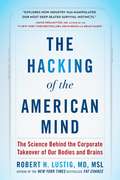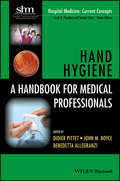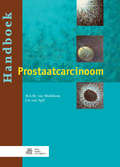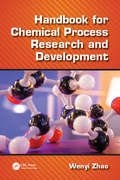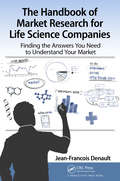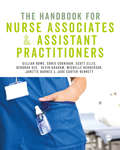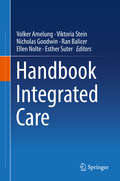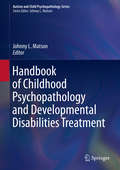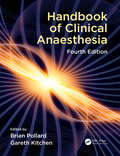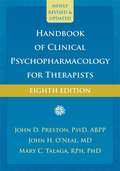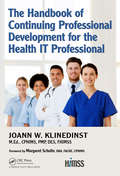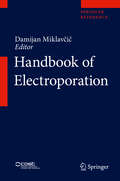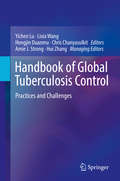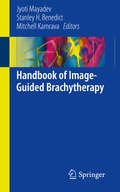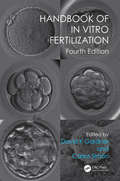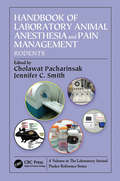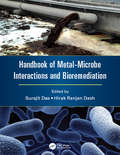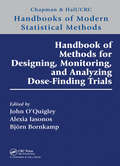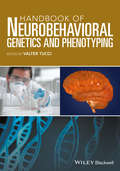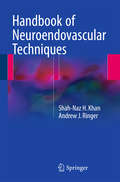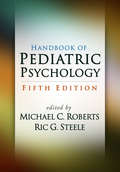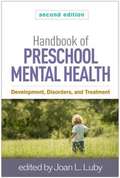- Table View
- List View
The Hacking of the American Mind: The Science Behind the Corporate Takeover of Our Bodies and Brains
by Robert H. Lustig"Explores how industry has manipulated our most deep-seated survival instincts."—David Perlmutter, MD, Author, #1 New York Times bestseller, Grain Brain and Brain MakerThe New York Times–bestselling author of Fat Chance reveals the corporate scheme to sell pleasure, driving the international epidemic of addiction, depression, and chronic disease. While researching the toxic and addictive properties of sugar for his New York Times bestseller Fat Chance, Robert Lustig made an alarming discovery—our pursuit of happiness is being subverted by a culture of addiction and depression from which we may never recover. Dopamine is the “reward” neurotransmitter that tells our brains we want more; yet every substance or behavior that releases dopamine in the extreme leads to addiction. Serotonin is the “contentment” neurotransmitter that tells our brains we don’t need any more; yet its deficiency leads to depression. Ideally, both are in optimal supply. Yet dopamine evolved to overwhelm serotonin—because our ancestors were more likely to survive if they were constantly motivated—with the result that constant desire can chemically destroy our ability to feel happiness, while sending us down the slippery slope to addiction. In the last forty years, government legislation and subsidies have promoted ever-available temptation (sugar, drugs, social media, porn) combined with constant stress (work, home, money, Internet), with the end result of an unprecedented epidemic of addiction, anxiety, depression, and chronic disease. And with the advent of neuromarketing, corporate America has successfully imprisoned us in an endless loop of desire and consumption from which there is no obvious escape. With his customary wit and incisiveness, Lustig not only reveals the science that drives these states of mind, he points his finger directly at the corporations that helped create this mess, and the government actors who facilitated it, and he offers solutions we can all use in the pursuit of happiness, even in the face of overwhelming opposition. Always fearless and provocative, Lustig marshals a call to action, with seminal implications for our health, our well-being, and our culture.
Hand Hygiene: A Handbook for Medical Professionals
by Benedetta Allegranzi Didier Pittet John M. BoyceThe first comprehensive, authoritative review of one of the most fundamental and important issues in infection control and patient safety, hand hygiene. Developed and presented by the world's leading scholar-clinicians, Hand Hygiene is an essential resource for all medical professionals. Developed and presented by the world leaders in this fundamental topic Fully integrates World Health Organization (WHO) guidelines and policies Offers a global perspective in tackling hand hygiene issues in developed and developing countries Coverage of basic and highly complex clinical applications of hand hygiene practices Includes novel and unusual aspects and issues in hand hygiene such as religious and cultural aspects and patient participation Offers guidance at the individual, institutional, and organizational levels for national and worldwide hygiene promotion campaigns
Handboek prostaatcarcinoom
by H.A.M. van MuilekomDit Handboek Prostaatcarcinoom is uniek in zijn soort. Het is het eerste Nederlandstalige boek voor professionals dat een zo volledig mogelijke beschrijving geeft van het probleem prostaatcarcinoom. Decennialang was er slechts beperkt aandacht voor deze ziekte, maar nu duidelijk is geworden dat prostaatcarcinoom na borstlong- en coloncarcinoom de meest voorkomende tumorsoort is in de westerse wereld, en de impact voor de volksgezondheid enorm is, neemt de aandacht voor dit probleem toe. De onbekendheid met het onderwerp bij vele werkers in de gezondheidszorg en de geringe belangstelling in de vakliteratuur waren voor de auteurs reden dit handboek samen te stellen. Het resultaat is een handboek over prostaatcarcinoom voor (gespecialiseerde) verpleegkundigen, (huis)artsen, fysiotherapeuten, maatschappelijk werkenden en andere paramedici, dat een zo breed mogelijk spectrum van de ziekte belicht. De overzichtelijke manier waarop het boek is opgezet en de schrijfstijl maken het handboek tevens bruikbaar voor patiënten en hun naasten.Het naslagwerk is samengesteld met de kennis en inzichten van dit moment. Het belicht de vele aspecten van prostaatcarcinoom en biedt handvatten voor gezondheidswerkers die in de dagelijkse praktijk met deze patiëntengroep te maken krijgen. Bij de totstandkoming van dit handboek is gebruik gemaakt van de deskundigheid en ervaring vanuit verschillende disciplines. Het handboek bestaat uit veertien hoofdstukken. Alle hoofdstukken beginnen met leerdoelen, zodat de lezer goed inzicht krijgt in de inhoud van het betreffende hoofdstuk. De hoofdstukken zijn geïllustreerd met tabellen, figuren, schema's, casussen en foto's om beter inzicht te geven in de beschreven onderwerpen en thema's. Deze opbouw maakt het handboek eenvoudig hanteerbaar en zeer geschikt als naslagwerk in de dagelijkse praktijk. Daarnaast is het goed bruikbaar voor onderwijsdoeleinden.
Handbook for Chemical Process Research and Development
by Wenyi ZhaoThe Handbook for Chemical Process Research and Development focuses on developing processes for chemical and pharmaceutical industries. Forty years ago there were few process research and development activities in the pharmaceutical industry, partially due to the simplicity of the drug molecules. However, with the increasing structural complexity, especially the introduction of chiral centers into the drug molecules and strict regulations set by the EMA and FDA, process R&D has become one of the critical departments for pharmaceutical companies. This book assists with the key responsibility of process chemists to develop chemical processes for manufacturing pharmaceutical intermediates and final drug substances for clinical studies and commercial production.
The Handbook for Market Research for Life Sciences Companies: Finding the Answers You Need to Understand Your Market
by Jean-Francois DenaultAs innovation moves from the lab to the market, a new research phase begins for the entrepreneur: the market research phase. Inspired by a new technology that can change the world, critical questions need to be addressed. Is there a market for my innovation? Who are my clients? What do they need? Is my innovation filling that gap in the market? Who are my competitors? How are they approaching the market? If these questions are unaswered, entrepreneurs meet potential investors or partners with only a basic understanding of their market. The objective of this book is to fill this gap. It is a practical manual that gives entrepreneurs real-world advice and tools to build a solid market model. The book provides tips, models and tools entrepreneurs can use to collect, interpret and present their market and integrate it into their business plan. What the entrepreneur learns in this book will help him throughout his journey. After going over the market research process, he will learn how to design and use a number of market research tools, and how to adapt them in a life science context. From building a web survey to preparing interviews to doing your own secondary research, this handbook will help him gain a comprehensive understanding of how to perform his own market research activities and how to analyze his data. Finally, a number of frameworks (such as the TAM-SAM-SOM as well as the KANO Model) are described so that he can efficiently share what he has learned, using models that simply yet effectively shares findings.
The Handbook for Nurse Associates and Assistant Practitioners
by Kevin Graham Gillian Rowe Chris Counihan Scott Ellis Deborah Gee Michelle Henderson Janette Barnes Jade Carter-BennettWritten specifically for students who are undertaking a foundation degree or higher level apprenticeship in healthcare practice, or for those studying for the new nurse associate role, this book provides readers with the core knowledge and skills, giving them a springboard to further study. Key features include: a one-stop shop for the course including a broad range of topics such as study skills, professional development, infection control and health promotion, health sciences, mental health, learning disabilities, children and families, clinical case studies throughout to show how theory relates to real-life practice different levels of activity to help students ‘step up learning’ whether they are at level 4 or 5 Written by a wide range of authors with both experience in practice and in running degrees in nursing and health, the book is essential reading for all healthcare support workers, assistant practitioners and nurse associates.
The Handbook for Nurse Associates and Assistant Practitioners
by Kevin Graham Gillian Rowe Chris Counihan Scott Ellis Deborah Gee Michelle Henderson Janette Barnes Jade Carter-BennettWritten specifically for students who are undertaking a foundation degree or higher level apprenticeship in healthcare practice, or for those studying for the new nurse associate role, this book provides readers with the core knowledge and skills, giving them a springboard to further study. Key features include: a one-stop shop for the course including a broad range of topics such as study skills, professional development, infection control and health promotion, health sciences, mental health, learning disabilities, children and families, clinical case studies throughout to show how theory relates to real-life practice different levels of activity to help students ‘step up learning’ whether they are at level 4 or 5 Written by a wide range of authors with both experience in practice and in running degrees in nursing and health, the book is essential reading for all healthcare support workers, assistant practitioners and nurse associates.
Handbook Integrated Care
by Volker Amelung, Viktoria Stein, Nicholas Goodwin, Ran Balicer, Ellen Nolte and Esther SuterThis handbook gives profound insight into the main ideas and concepts of integrated care. It offers a managed care perspective with a focus on patient orientation, efficiency, and quality by applying widely recognized management approaches to the field of health care. The handbook also provides international best practices and shows how integrated care does work throughout various health systems. The delivery of health and social care is characterised by fragmentation and complexity in most health systems throughout the world. Therefore, much of the recent international discussion in the field of health policy and health management has focused on the topic of integrated care. “Integrated” acknowledges the complexity of patients´ needs and aims to meet it by taking into account both health and social care aspects. Changing and improving processes in a coordinated way is at the heart of this approach.
Handbook of Childhood Psychopathology and Developmental Disabilities Treatment (Autism and Child Psychopathology Series)
by Johnny L. MatsonThis handbook explores the rapid growth in childhood developmental disabilities (DD) treatments. It reviews current evidence-based treatments for common psychopathologies and developmental disorders and evaluates the strengths of the treatments based on empirical evidence. Spanning infancy through the transition to young adulthood, chapters provide definitions, etiologies, prevalence, typical presentation and variants, assessment and diagnostic information, and age considerations. Chapters also review established and emerging psychological approaches and pharmacotherapies for cognitive, behavioral, emotional, medical, academic, and developmental issues as diverse as mood disorders, the autism spectrum, memory problems, feeding disorders, Tourette syndrome, and migraines. The wide range of topics covered aids practitioners in working with the complexities of young clients’ cases while encouraging further advances in an increasingly relevant field. Topics featured in this handbook include:An introduction to Applied Behavior Analysis.Parent training interventions.Treatment strategies for depression in youth.Assessment and treatment of self-injurious behaviors in children with DD. Treatment approaches to aggression and tantrums in children with DD.Interventions for children with eating and feeding disorders. The Handbook of Childhood Psychopathology and Developmental Disabilities Treatment is a must-have resource for researchers, graduate students, clinicians, and related therapists and professionals in clinical child and school psychology, pediatrics, social work, developmental psychology, behavioral therapy/rehabilitation, child and adolescent psychiatry, and special education.
Handbook of Clinical Anaesthesia, Fourth edition
by Brian Pollard Gareth KitchenWritten and edited by experts in the field, the Handbook of Clinical Anaesthesia provides all the essential practical knowledge required by anaesthetists on co-existing medical conditions, operative procedures, and techniques. The fourth edition retains the concise and comprehensive nature of the third, giving readers all they need to know about each part of the FRCA syllabus in short, digestible, practical entries. <P><P> The first part covers Patient Conditions; the second Surgical Procedures; and the third Anaesthetic Factors. Each part is subdivided into chapter on each organ system, and each chapter is divided into bite-sized entries. These are in alphabetical order, and cover all common and rare conditions that anaesthetists will encounter within their practice. Avoiding prolonged discussion and multiple references, this is the ideal book to ‘dip into’ either for specific advice or general education, providing quick and reliable information. <P><P> This is the most thorough handbook to cover the entire FRCA syllabus in a consistent and instructive manner. It continues to be accessible and relevant to all anaesthetists from middle grade trainee up to consultant/specialist.
Handbook Of Clinical Psychopharmacology For Therapists
by John D. Preston John H. O'Neal Mary C. TalagaThis book is intended primarily for mental health professionals and those in graduate training in psychology, social work, psychiatric nursing, and counseling. The professional goal of most readers will be to provide services that aim to reduce emotional pain, to promote psychological growth and healing
The Handbook of Continuing Professional Development for the Health IT Professional (HIMSS Book Series)
by JoAnn KlinedinstContinuing professional development (CPD) is critical for the health IT professional. Healthcare is fast-paced, dynamic, ever-changing, and global. It’s both exciting and exhausting. And it is rapidly evolving through innovation, Federal incentives, and technological advancements. For these reasons, health IT professionals must embrace lifelong learning to ensure they have the professional competencies to advance initiatives that positively impact patient care. This handbook will provide the rationale and the resources to do so and will serve as a reference to accompany one’s career success.
Handbook of CTG Interpretation
by Edwin ChandraharanThis book promotes an evidence-based paradigm of fetal heart rate monitoring during labour, with a move away from the traditional 'pattern-based' interpretation to physiology-based interpretation. Chapters are presented in a systematic and accessible format, covering topics such as non-hypoxic causes of fetal brain injury, pre-existing hypoxia, types of intrapartum hypoxia, erroneous monitoring of maternal heart rate, fetal scalp blood sampling and fetal ECG (STAN), intermittent auscultation and medico-legal issues. Sections on 'pearls' and 'pitfalls' highlight good practice and common errors to promote best practice. End-of-chapter exercises allow the reader to engage with the theory and test their knowledge of key areas. This is a highly practical manual aimed at obstetricians and midwives, particularly those undergoing CTG training. The book will also be very useful to midwifery and medical students and to all those involved in multiprofessional intrapartum care.
Handbook of Electroporation
by Damijan MiklavčičThis major reference work is a one-shot knowledge base on electroporation and the use of pulsed electric fields of high intensity and their use in biology, medicine, biotechnology, and food and environmental technologies. The Handbook offers a widespread and well-structured compilation of 156 chapters ranging from the foundations to applications in industry and hospital. It is edited and written by most prominent researchers in the field. With regular updates and growing in its volume it is suitable for academic readers and researchers regardless of their disciplinary expertise, and will also be accessible to students and serious general readers. The Handbook's 276 authors have established scholarly credentials and come from a wide range of disciplines. This is crucially important in a highly interdisciplinary field of electroporation and the use of pulsed electric fields of high intensity and its applications in different fields from medicine, biology, food processing, agriculture, process engineering, energy and environment. An Editorial Board of distinguished scholars from across the world has selected and reviewed the various chapters to ensure the highest quality of this Handbook.The book was edited by an international team of Section Editors: P. Thomas Vernier, Boris Rubinsky, Juergen Kolb, Damijan Miklavcic, Marie-Pierre Rols, Javier Raso, Richard Heller, Gregor Serša, Dietrich Knorr, and Eugene Vorobiev.
Handbook of Global Tuberculosis Control
by Yichen Lu Lixia Wang Hongjin Duanmu Chris Chanyasulkit Amie J. Strong Hui ZhangThis ambitious reference surveys worldwide efforts at controlling the spread of tuberculosis, with special emphasis on the developing world. Case studies from China, Pakistan, Nigeria, Indonesia, and other frontline countries demonstrate a wealth of information on clinical, cultural, socioeconomic, and other relevant factors. This compilation provides a valuable resource for creating successful intervention and prevention strategies. State-of-the-science snapshots pinpoint where short- and long-term initiatives stand today, from early detection and vaccination programs to new genetic technologies and drug therapies. This diverse group of perspectives and approaches offers innovative paths toward control and realistic odds for containing the threat, especially in the face of current co-epidemics and new drug-resistant strains. Among the topics in the Handbook: Diagnosis of tuberculosis: current pipeline, unmet needs, and new developments Concurrence of tuberculosis and other major diseases The tuberculosis outbreak response, investigation, and control The promise of new TB vaccines DNA fingerprinting of Mycobacterium tuberculosis: a rich source of fundamental and daily applicable knowledge Global tuberculosis surveillance The Handbook of Global Tuberculosis Control is urgent reading for leadership and staff of non-governmental organizations, government agencies, academic institutions, research centers, hospitals, and potentially businesses with interests in tuberculosis control. Additionally, the book's focus on TB in developing countries will attract a wider audience of practitioners, particularly those working in the broader fields of global public health, epidemiology, international development, and the socioeconomics of infectious diseases.
Handbook of Gynecology
by Donna ShoupeCovering all aspects of gynecology commonly encountered in day-to-day practice, this exhaustive work provides a practical, one-stop reference work for clinicians working in the field. This carefully-designed volume includes ten sections, beginning with comprehensive coverage of office-based gynecology, and continuing on to present disease processes and management information by patient age group. Each chapter includes background information, current recommendations for screening, diagnostic criteria, common and uncommon associated problems, approach to diagnosis, summary of treatment options, and an overview of ICD-9/10 codes for specific diagnoses. The handbook concludes with an easy-to-navigate presentation of minimally-invasive operations, surgical procedures, neoplasms, and pathology. Advantages and risks associated with management of particular diseases are covered, along with multiple tips for avoiding complications. Edited by experts and presenting the most recent developments in gynecological practice, The Handbook of Gynecology is an invaluable reference for OB/GYNs, family medicine and internal medicine clinicians, medical students, residents, physician assistants, nurse practitioners, and other healthcare providers.
Handbook of Image-Guided Brachytherapy
by Jyoti Mayadev Stanley H. Benedict Mitchell KamravaThis handbook provides a clinically relevant, succinct, and comprehensive overview of image-guided brachytherapy. Throughout the last decade, the utility of image guidance in brachytherapy has increased to enhance procedural development, treatment planning, and radiation delivery in an effort to optimize safety and clinical outcomes. Organized into two parts, the book discusses physics and radiobiology principles of brachytherapy as well as clinical applications of image-guided brachytherapy for various disease sites (central nervous system, eye, head and neck, breast, lung, gastrointestinal, genitourinary, gynecologic, sarcoma, and skin). It also describes the incorporation of imaging techniques such as CT, MRI, and ultrasound into brachytherapy procedures and planning. Featuring procedural and anesthesia care, extensive images, contouring examples, treatment planning techniques, and dosimetry for the comprehensive treatment for each disease site, Handbook of Image-Guided Brachytherapy is a valuable resource for practicing radiation oncologists, physicists, dosimetrists, residents, and medical students.
Handbook of In Vitro Fertilization
by David K. Gardner Carlos SimónThe new edition of this text admirably fills the need for a primer on the central topics involved in Human In Vitro Fertilization (IVF). Supplying a comprehensive and hands-on approach to IVF, this source presents established state-of-the-art procedures and techniques, as well as the most current research in the field. Expert contributors also discuss the history of IVF and the potential of future research. Offering essential information for reproductive endocrinologists, IVF practitioners and embryologists, this book guides readers though every step of human assisted conception, from patient pre-treatment to monitoring of outcomes.
Handbook of Laboratory Animal Anesthesia and Pain Management: Rodents (Laboratory Animal Pocket Reference)
by Cholawat Pacharinsak Jennifer C. SmithKey features: Presents practical information in easily accessible ‘bullet point’ format Covers anesthetic machine and related equipment, anesthetic management and monitoring, anesthesia and analgesia pharmacology, euthanasia, and record keeping Written by well-recognized experts in the laboratory animal community Provides extensive references to direct the reader to sources for further study of alternative techniques and their procedures Concludes with a thorough chapter on Regulatory Management of Rodent Anesthesia which has global application Rodents are the most commonly used species in biomedical research. Individuals conducting rodent research are often responsible to ensure that all areas of anesthesia and analgesia are performed humanely. Anesthetic agent selection, anesthetic monitoring, and postoperative pain assessment and management are essential to the institutional animal care and use program and contribute significantly to the 3Rs by reducing pain and/or distress and refining various procedures. The Handbook of Laboratory Animal Anesthesia and Pain Management: Rodents is the first book to capture multiple advances in this important area that greatly impacts various experimental methodologies. Richly illustrated in full color, the book serves as a quick reference source for investigators, veterinarians, technicians, and other animal caretakers charged with the care and use of rodents in a research setting. The unique format of this book also makes it extremely valuable to IACUC members, institutional officials, and occupational health and safety professionals.
Handbook of Metal-Microbe Interactions and Bioremediation
by Surajit Das Hirak Ranjan DashAround the World, metal pollution is a major problem. Conventional practices of toxic metal removal can be ineffective and/or expensive, delaying and exacerbating the crisis. Those communities dealing with contamination must be aware of the fundamentals advances of microbe-mediated metal removal practices because these methods can be easily used and require less remedial intervention. This book describes innovations and efficient applications for metal bioremediation for environments polluted by metal contaminates.
Handbook of Methods for Designing, Monitoring, and Analyzing Dose-Finding Trials
by Alexia Iasonos Björn Bornkamp John O'QuigleyHandbook of Methods for Designing, Monitoring, and Analyzing Dose-Finding Trials gives a thorough presentation of state-of-the-art methods for early phase clinical trials. The methodology of clinical trials has advanced greatly over the last 20 years and, arguably, nowhere greater than that of early phase studies. The need to accelerate drug development in a rapidly evolving context of targeted therapies, immunotherapy, combination treatments and complex group structures has provided the stimulus to these advances. Typically, we deal with very small samples, sequential methods that need to be efficient, while, at the same time adhering to ethical principles due to the involvement of human subjects. Statistical inference is difficult since the standard techniques of maximum likelihood do not usually apply as a result of model misspecification and parameter estimates lying on the boundary of the parameter space. Bayesian methods play an important part in overcoming these difficulties, but nonetheless, require special consideration in this particular context. The purpose of this handbook is to provide an expanded summary of the field as it stands and also, through discussion, provide insights into the thinking of leaders in the field as to the potential developments of the years ahead. With this goal in mind we present: An introduction to the field for graduate students and novices A basis for more established researchers from which to build A collection of material for an advanced course in early phase clinical trials A comprehensive guide to available methodology for practicing statisticians on the design and analysis of dose-finding experiments An extensive guide for the multiple comparison and modeling (MCP-Mod) dose-finding approach, adaptive two-stage designs for dose finding, as well as dose–time–response models and multiple testing in the context of confirmatory dose-finding studies.? John O’Quigley is a professor of mathematics and research director at the French National Institute for Health and Medical Research based at the Faculty of Mathematics, University Pierre and Marie Curie in Paris, France. He is author of Proportional Hazards Regression and has published extensively in the field of dose finding. Alexia Iasonos is an associate attending biostatistician at the Memorial Sloan Kettering Cancer Center in New York. She has over one hundred publications in the leading statistical and clinical journals on the methodology and design of early phase clinical trials. Dr. Iasonos has wide experience in the actual implementation of model based early phase trials and has given courses in scientific meetings internationally. Björn Bornkamp is a statistical methodologist at Novartis in Basel, Switzerland, researching and implementing dose-finding designs in Phase II clinical trials. He is one of the co-developers of the MCP-Mod methodology for dose finding and main author of the DoseFinding R package. He has published numerous papers on dose finding, nonlinear models and Bayesian statistics, and in 2013 won the Royal Statistical Society award for statistical excellence in the pharmaceutical industry. ? ?
Handbook of Neurobehavioral Genetics and Phenotyping
by Valter TucciThe Handbook of Behavioral Genetics and Phenotyping represents an integrative approach to neurobehavioural genetics; worldwide experts in their field will review all chapters. Advanced overviews of neurobehavioural characteristics will add immense value to the investigation of animal mutants and provide unique information about the genetics and behavioural understanding of animal models, under both normal and pathological conditions. Cross-species comparisons of neurobehavioural phenotypes will pave the way for an evolutionary understanding of behaviour. Moreover, while biological sciences are progressing towards a holistic approach to investigate the complexity of organisms (i.e., “systems biology” approach), an integrated analysis of behavioural phenotyping is still lacking. The Handbook of Behavioral Genetics and Phenotyping strengthens the cross-talk within disciplines that investigate the fundamental basis of behaviour and genetics. This will be the first volume in which traditionally distant fields including genomics, behaviour, electrophysiology, neuroeconomics, and computational neuroscience, among others, are evaluated together and simultaneously accounted for during discussions of future perspectives.
Handbook of Neuroendovascular Techniques
by Shah-Naz H. Khan Andrew J. RingerThis handbook provides step-by-step instructions enabling even a novice in the field of interventional neuroradiology/endovascular neurosurgery to perform a procedure. It covers the breadth of mainstream endovascular techniques. This manual provides lucid, readily accessible and pertinent hands-on information. It focuses on practicalities such as technique, choice of equipment and rationale, contrast agents, medications, precise pre- and post-procedure management and management of complications. It does not elaborate on theoretical aspects of disease e. g. , etiology, pathogenesis, statistics, etc. In essence, it provides the necessary information to enable performance of a procedure. Handbook of Neuroendovascular Techniques will be a great resource for a whole range of physicians from residents, to those just embarking on their own independent practice to established experts reviewing methodology of a technique. The authors have a depth of experience and are highly qualified, ensuring objective, pertinent, authoritative and competent coverage of subject matter.
Handbook of Pediatric Psychology, Fifth Edition
by Michael C. Roberts Ric G. SteeleThousands of practitioners and students have relied on this handbook, now thoroughly revised, for authoritative information on the links between psychological and medical issues from infancy through adolescence. Sponsored by the Society of Pediatric Psychology, the volume explores psychosocial aspects of specific medical problems, as well as issues in managing developmental and behavioral concerns that are frequently seen in pediatric settings. The book describes best practices in training and service delivery and presents evidence-based approaches to intervention with children and families. All chapters have been rigorously peer reviewed by experts in the field. New to This Edition: *Chapters on rural health, the transition to adult medical care, prevention, and disorders of sex development. *Expanded coverage of epigenetics, eHealth applications, cultural and ethnic diversity, spina bifida, and epilepsy. *Many new authors; extensively revised with the latest with the latest information on clinical populations, research methods, and interventions. *Chapters on training and professional competencies, quality improvement and cost-effectiveness, and international collaborations. See also Clinical Practice of Pediatric Psychology, edited by Michael C. Roberts, Brandon S. Aylward, and Yelena P. Wu, which uses rich case material to illustrate intervention techniques.
Handbook of Preschool Mental Health, Second Edition: Development, Disorders, and Treatment
by Joan L. LubyComprehensively exploring the development of psychiatric disorders in 2- to 6-year-olds, this authoritative handbook has been thoroughly revised to incorporate important scientific and clinical advances. Leading researchers examine how behavioral and emotional problems emerge and can be treated effectively during this period of rapid developmental and brain changes. Current knowledge is presented on conduct disorders, attention-deficit/hyperactivity disorder, anxiety disorders, depressive disorders, autism spectrum disorder, attachment disorders, and sleep disorders in very young children. The volume reviews a range of interventions for preschoolers and their caregivers--including clear descriptions of clinical techniques--and discusses the strengths and limitations of the empirical evidence base. New to This Edition *Many new authors; extensively revised with the latest research and empirically supported treatments. *Heightened focus on brain development and the neural correlates of disorders. *Section on risk and resilience, including chapters on sensitive periods of development and the early environment. *Chapters on parent-child interaction therapy, cognitive-behavioral therapies, attachment-based therapies, and translational approaches to early intervention.
